 When considering options, do you suffer from analysis paralysis? Or, do you impulsively react? To counter both of these approaches use the “if … then technique:”
When considering options, do you suffer from analysis paralysis? Or, do you impulsively react? To counter both of these approaches use the “if … then technique:”
· If I do ____ then ____ will happen.
For example, you have two job offers and must decide which to accept. One seems more interesting but pays significantly less; the other pays more but requires working more hours:
If I take the job that seems more interesting but pays less, then:
• I could only pay small amounts off my debt monthly.
• I’d enjoy my work more and be less stressed.
• Commuting would be less expensive and time-consuming since the job is closer to home.
• I’d spend more time with my family because I’d work fewer hours.
If I take the higher paying job, then:
• More commute time and over-time would keep me away from home more.
• With less time at home doing household chores and spending time with the family would become more challenging.
• My family might step up and help with chores. Maybe they’d even appreciate what I do around the house more.
• I could hire a housekeeper.
At first glance this technique seems like just the pros and cons of your choices. It’s different, however, in that it encourages you to think in terms of the consequences of your options. It helps you think before you act.
· If you rescue your child from her irresponsible behavior again then you’ll teach her you’ll rescue her and she won’t have to responsibility for herself.
· If you buy that expensive outfit then you’ll have less money and you’ll look great for the party. This forces you to choose what you value more: looking great or saving money.
To avoid the ready-aim-aim-aim-and-never-fire or the ready-fire-aim approaches, use if … then and join the ready-aim-fire group.
A second and different use of “if … then” is in planning and helping you accomplish goals.
For instance, for a weight loss goal, use if … then:
1. If ____ happens, then I’ll do ____.
o E.g., If dessert is offered I’ll decline and request water.
2. Then, add your specific goal: I’ll walk 30 minutes weekdays at 6:30 a.m.
NYU psychologist, Peter Gollwitzer reviewed 94 studies that researched people who used this 2-step planning technique and found significantly higher success rates for just about any goal. He explains it works because it speaks the language of your brain: the language of contingencies.
Deciding exactly how you’ll react to circumstances regarding your goal creates a link in your brain between the situation or cue (if) and the behavior that should follow (then.)
• When dessert is offered (cue) it links to your desired behavior – turn it down and request water.
Gollwitzer says this link keeps you from having to consciously monitor your goal. Your plans get carried out without apparent effort.
I’ve used this approach recently and have been very successful in achieving my stated goal. I encourage you to try it, too.
Jacquelyn Ferguson, M. S., is an international speaker and a Stress and Wellness Coach. Order her book, Let Your Body Win: Stress Management Plain & Simple, at https://wholeperson.com/x-selfhelp/selfhelp.html#Anchor-Let-11481.
Like this:
Like Loading...

 When considering options, do you suffer from analysis paralysis? Or, do you impulsively react? To counter both of these approaches use the “if … then technique:”
When considering options, do you suffer from analysis paralysis? Or, do you impulsively react? To counter both of these approaches use the “if … then technique:”
